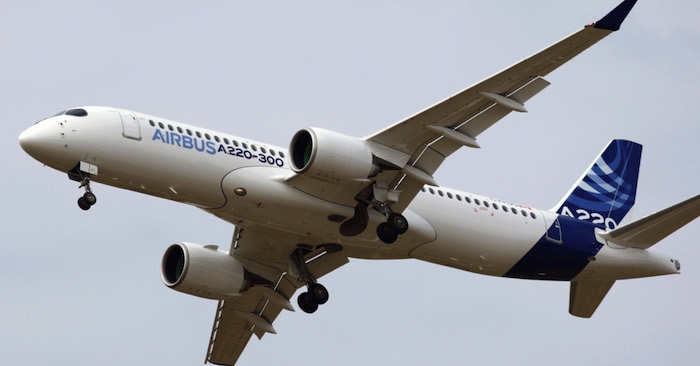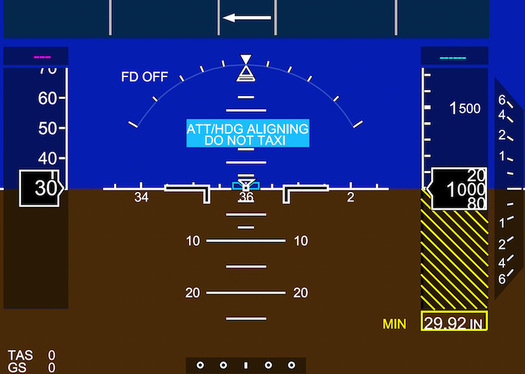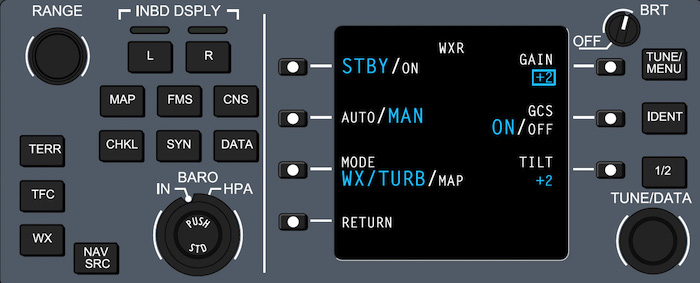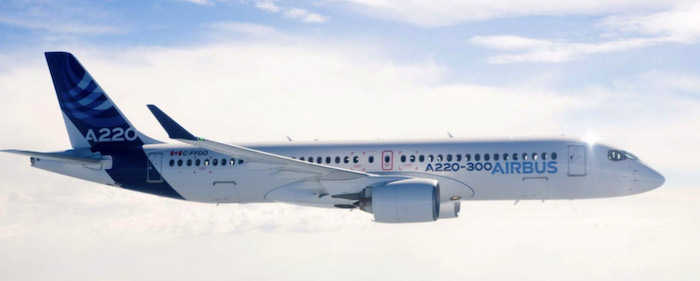During climb, the antenna tilt angle is automatically decreased. A radar beam detects high-altitude thunderstorms. A second beam is set at a lower tilt angle to detect weather at extended ranges and prevent over-scanning of weather with turbulence threat in the vicinity of the aircraft. When the aircraft is above _____, overflight protection becomes active.
Weather radar (WXR) system - The WXR can be manually selected ON at any time. When the WXR is selected ON while on the ground, WXR ON message is displayed in _____ on the HSI.
On takeoff, if the weather radar detects windshear conditions (wind shift variance around cells), a 'MONITOR RADAR DISPLAY' aural caution alert sounds.
An amber WSHR AHEAD message is displayed on the ADI. If the detection continues when the aircraft is in the warning area, a 'WINDSHEAR AHEAD, WINDSHEAR AHEAD' aural warning alert sounds. A red WSHR AHEAD message is displayed on the ADI.
After successful alignment, the Inertial Reference Units (IRUs) transfers to navigation mode. The time required for an Stationary Alignment (SA) mode is dependent on the aircraft latitude. Alignment time is from 5 minutes at 0 degrees latitude to approximately 10 minutes between 60 degrees and 70 degrees latitude, and is up to _____ above 70 degrees latitude.
Weather radar (WXR) system - The WX mode is the normal mode. This mode can detect returns related to the intensity and type of precipitation, as follows:
This mode cannot detect windshear, clouds, or lightning.
If a dual IRS failure occurs (which includes IRS 3), the remaining IRS is displayed in red on the FMA. At the same time, the 'IRS SAME SOURCE' caution message is displayed on the EICAS page.
If a dual IRS failure occurs (which includes IRS 3), the remaining IRS is displayed in amber on the FMA. At the same time, the IRS SAME SOURCE caution message is displayed on the EICAS page as well as two advisory messages that correspond to the failed IRS.
P-RAIM (Predictive RAIM function) determines if sufficient GNSS coverage is available to support a GNSS-based approach at the destination or alternate airport at the planned arrival time.
To provide position, velocity, and time data. The GNSS receivers interface with:
During a TAWS or a TCAS alert, the WXR image is removed.
After a TAWS alert, the weather image is automatically restored. However, after a TCAS alert the crew must select WX on the CTP or from the OVLY tab menu to display the weather image again.
TCAS aural alerts - Some aural alerts are inhibited below specific radio altitudes. All RA command aural alerts are inhibited below _____
TCAS automatically changes to the TA ONLY mode.
Advertisement
The GPS receivers require a minimum of _____ satellites for a 3D position solution. The system is automatically active when the aircraft has electrical power.
The Traffic Alert and Collision Avoidance System (TCAS) provides surveillance, threat detection, and conflict resolution. It displays transponder-equipped aircraft that are within a maximum _____ range.

An 'ATT/HDG ALIGNING − DO NOT TAXI' message is displayed on each PFD while:

During the alignment of IRS 3, the caution message IRS 3 ALIGNING is displayed on the EICAS page
Weather radar (WXR) system - The MAP mode enables display of both terrain and weather returns.
The Ground Clutter Suppression (GCS) is disabled in MAP mode. The MAP mode displays the ground returns when there is no significant weather in the area. Receiver sensitivity is decreased to accommodate terrain characteristics. This mode enables identification of terrain features such as mountains, coastlines, and bodies of water.
The predictive windshear function uses weather radar information to predict windshear conditions during takeoff and approach. Windshear detection is active when the weather radar:
During the SA mode, the IRS uses the GPS position data as an automatic source for position entry.
It can also use a position entered by the flight crew in the FMS as a valid source.
When a traffic advisory is detected (TA target), TA ONLY is displayed in amber and flashes _____.
Weather radar (WXR) system - The WX/TURB mode shows the same weather picture as the WX mode, plus the turbulence associated with precipitation. This mode can detect Clear-Air Turbulence (CAT) in certain conditions.

This mode cannot detect Clear-Air Turbulence (CAT).
The Inertial Reference Units (IRUs) enter the Stationary Alignment (SA) mode on ground with no excessive aircraft movement. Aircraft speed must be less than _____.
The WXR is automatically on when:
Advertisement
The TCAS information and alerts are displayed on the:
When a TCAS RA is active, the Flight Director (FD) and FMS V/S guidance are not displayed on the PFD until the TCAS RA threat is cleared.
If air data and GNSS inputs are not available, the IRS stays in the reversionary attitude mode, and provides attitude and heading information only.
Satellite-Based Augmentation System (SBAS) provides Receiver Autonomous Integrity Monitoring (RAIM) for non-precision approach. The GNSS receivers support all Satellite Based Augmentation System (SBAS) operations, including Localizer Performance with Vertical Guidance (LPV) approaches. How many satellites are required for RAIM?
After takeoff, the TCAS provides traffic advisories only. This prevents an RA at low altitude. A TA ONLY message is displayed on the TCAS section of the HSI. When the aircraft reaches _____ the TCAS provides TA and RA as required. There are no messages displayed during TA/RA operation.
When the aircraft descends below 1100 feet AGL, the TCAS returns to in-traffic advisories only and a TA ONLY message is displayed on the TCAS section. After landing, the TCAS automatically turns off and a TCAS OFF message is displayed.
Resolution Advisory (RA) - Climb command is not issued if it takes the aircraft above _____.
TAWS operation - When the aircraft enters the terrain warning range a 'TERRAIN, TERRAIN, PULL UP, PULL UP' or 'OBSTACLE, OBSTACLE, PULL UP, PULL UP' alert sounds _____ before the terrain/obstacle conflict can occur.
A red PULL UP visual alert is displayed on the PFD.
Terrain Awareness and Warning System (TAWS) operation is automatic and requires no selections or actions.

The Global Navigation Satellite System (GNSS) includes three Global Positioning System (GPS) receivers in the forward equipment bay and two antennas.
The Global Navigation Satellite System (GNSS) includes two Global Positioning System (GPS) receivers in the forward equipment bay and two antennas
Weather radar (WXR) system - During takeoff, the WXR antenna is set to approximately 4 degrees to 7 degrees up and uses multiple beams at different tilt settings, and also ground clutter suppression and PAC to produce a clutter-free display before takeoff. Weather radar operation on the ground is optimized to display hazardous weather within approximately _____.
Advertisement
When the STBY (Standby) mode is selected, the transponder is in standby mode and the TCAS is off. A TCAS OFF message is displayed in amber on the TCAS section of the HSI.
What is the true statement?
IRS 3 automatically takes over a failed IRS and is displayed as a white IRS 3 message on the FMA. An advisory message is also displayed on the EICAS page to indicate which IRS has failed.
TAWS operation - When the terrain elevation that surrounds the aircraft is between _____ the aircraft, it is displayed in yellow.
When the terrain elevation exceeds 2000 feet above the aircraft, it is displayed in red.
In a Traffic Alert (TA) situation, the MAP range will be set automatically to 20 nm.
In a Traffic Alert (TA) situation, the MAP range will be set automatically to 10 nm.
On-ground, the stationary alignment mode is not affected by normal ramp activity such as fueling or loading. However, excessive motion, push-back or taxiing may cause the IRS to restart the full alignment. This will only occur _____ after motion stops.
The Align-In-Motion (AIM) mode is used for alignment while the aircraft is in motion and enables the IRUs to recover full navigation capability if there is an in-flight power interruption. The time period of the AIM varies from _____, depending on the flight dynamic conditions (rate of change in heading and acceleration, etc.).
Flight with no heading and acceleration changes may cause the time to exceed 25 minutes. Aircraft maneuvers with changes in heading and acceleration may reduce alignment time to 15 minutes or less.
TCAS aural alerts - Some aural alerts are inhibited below specific radio altitudes. The 'INCREASE DESCENT. INCREASE DESCENT' aural alert is inhibited below _____
Weather radar (WXR) system - The TURB mode shows only the turbulence associated with precipitation. Only detected turbulence within a _____ range is displayed, regardless of the selected WXR range.
This mode is useful to isolate zones that have been identified with the WX/TURB mode. The system remains in TURB mode for 30 seconds, then reverts to WX/TURB mode.
TCAS altitude limits - When the TCAS is not in AUTO mode, the ALT LIMIT selection enables the flight crew to choose the range of the traffic detection around the aircraft. The ALT LIMIT LSK on the XPDR/TCAS CONTROL page has four different selections: NORM, ABOVE, BELOW, and ABOVE/BELOW. The ABOVE and BELOW selection displays all the traffic detected within _____ around the aircraft altitude.
When a resolution advisory is activated, the TCAS provides aural alerts to advise of incoming traffic and required maneuver. The aural alerts cannot be muted or reduced in volume. Only STALL warning and TAWS windshear aural alerts have priority over TCAS alerts.
Advertisement
TAWS operation - When the aircraft enters the terrain caution range, a TAWS 'CAUTION TERRAIN, CAUTION TERRAIN' or 'CAUTION OBSTACLE, CAUTION OBSTACLE' alert sounds _____ before the terrain/obstacle conflict can occur and is repeated every 7 seconds while the aircraft remains within the conflict caution area.
An amber GND PROX visual alert is displayed on the PFD.
